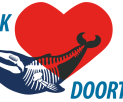Say ‘bye bye’ to Doortje
‘We’re pretty much done with it,’ says museum curator Rolf ter Sluis, now that it has been announced that nature education museum Wad & Zoo has, after two years, decided not to adopt the 200,000 kilogram skeleton. ‘We’ve been waiting for two years. But everything was depending on them getting a grant, and that fell through.’
The museum peddled the skeleton, which was stored in the basement of the former Biology Centre in Haren, for four years. When the centre was being sold, there was no more room for the giant bones. The UK then created a Facebook page for ‘Doortje’. There were responses from all over the world: not just from museums, but also from amusement parks, artists, and shamans who wanted to cut the bones into pieces for their healing powers. From BNN to Edwin Evers to the Jeugdjournaal, all the media were reporting on it.
In storage
But a solution remained elusive. A Life Sciences action committee – who wanted to house Doortje in the Linnaeusborg – failed to raise sufficient funds to mount and display the skeleton. For a while she was stored at Zernike and then she was given her own exhibition in the museum, but eventually ended up back in the warehouse.
- The bones in the bike storage at the Biology Centre.
- The bones in the bike storage at the Biology Centre.
- The bones after being packed up following the conclusion of the ‘Stranded’ exhibit.
Then, the plan was for her to move to the Natural Museum in Leeuwarden. Doortje – or rather Dorus, since research had determined that the skeleton is actually male – was going to live in the new whale room, together with a sperm whale. But that plan failed as well: Doortje turned out to be too big.
Cleaved
For the past two years, Doortje had been waiting for her move to future nature education museum Wad & Zoo. ‘But we also knew that Naturalis was interested. A former employee of ours, Kobus Boeke, now works there. He had always been interested in her because her history has been documented from the moment she beached’
The corpse was sold for 75 guilders in 1910 and placed on display in Middelburg. People had to pay 10 cents to come see her. She was transported to Groningen, spent years on the zoological lab’s roof, and finally ended up in the bicycle storage in Haren. ‘What’s also really interesting is the fact that her pelvis is intact, but her skull has been cleaved’, says Ter Sluis.
Commitment
Doortje will probably be donated to Naturalis. ‘Loaning out items is outdated’, say Ter Sluis. ‘Besides, when something is on loan, people usually don’t invest in its conservation. But Naturalis will.’ Mounting the bones will easily cost between 10,000 and 15,000 euros.
Doortje will be transported to Leiden this month. Is that too bad? ‘She’s in the warehouse and nobody really has any use for her. It seems that there is not enough structural commitment to do something to keep her’, says Ter Sluis. ‘I don’t blame anyone for that, but it’s true.’









